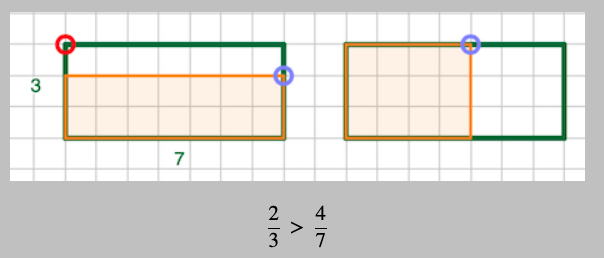Blog Posts
Here are links to posts on my Math Education Blog that you might find interesting.
If you are so moved, you may comment on the posts, and/or subscribe to the blog.
What Belongs in Algebra 2
Gail Burrill is a math educator from Michigan, and among much else, a past President of NCTM. I attended her presentation on "what belongs in Algebra 2". I loved the fact that she had solid ideas on how to acknowledge the existence of technology, all the way to ChatGPT, and adjust instruction accordingly. She also was acutely aware of most students' mathematical maturity, and suggested moving some of the more complicated topics up to precalculus. And unlike many, she insisted that quantitative literacy ("data science" basics) should be taught in addition to, not instead of Algebra 2 topics. Read about her presentation and my commentary here.
Fractions
My first ten years in this line of work were spent in elementary school. When teaching 4th and 5th grade, I developed an approach to fractions: the well-chosen rectangle. As far as I can tell, it is not widely practiced, so I decided to present it at the Asilomar conference. I usually speak on secondary school topics, and there were numerous other presentations on fractions. Still, to my surprise, the talk was well attended. People seemed to get something out of it, as did I! See my notes here.

Manipulatives
One thing I brought with me when I transitioned from K-5 to high school was an interest in using manipulatives as an environment for students to reflect, discuss, and write about math. I link to a lot of curricular materials along these lines (and to some virtual manipulatives) on my Manipulatives home page.
Liz Caffrey is a middle school teacher in the Boston area, and the host of a terrific summer institute for K-8 teachers. She wrote a guest post for my blog about how she uses manipulatives. I featured photos she sent me in a post about Another Use for the Lab Gear. The "other use" in question was perimeter and surface area problems. Approaching those with the Lab Gear provides an excellent algebra-geometry connection, and a great motivator for student engagement.
A Construction Unit
In this post I share a subset of a longer geometric construction unit. The idea is to present geometric construction as a sequence of puzzles to solve, rather than a bunch of recipes to memorize. (Here is an old post where I make the case for this approach.)
MathEducation.page
New on my website.
Teaching Math in the Long Period

I spent my last 30+ classroom years as a high school math teacher and department chair. As it turns out, I worked in a school with a so-called block schedule, in other words long periods — an excellent environment to develop an effective student-centered, teacher-led pedagogy. In many schools that are considering a switch to a block schedule there is some resistance from the math department. This resistance is sufficiently widespread to have resulted in ten consulting jobs for me over the years, each of them a chance to share my insights about how to make good use of that transition. In my view, math teachers' attachment to short periods is, well, short-sighted. The long period does present some real challenges, but it offers opportunities for more variety, more depth, and more learning. Read all about it here.
New PDFs
I added:
- A guided inquiry worksheet about The Three Triangles proof of the Pythagorean Theorem. I hope to write much more about this in time for my next newsletter.
- Liz Caffrey’s version of Angles Around a Point (Lab 1.1 in Geometry Labs).
Tweaks, Updates, and Stats
- I tweaked and updated:
- The Site Map by Grade Level (possibly a good entry point to the site?)
- The Fractions home page and the "pie" representation page: Slices.
- The Tiling home page (lots of tessellation links!)
- My résumé (take a look if you're thinking of hiring me as a consultant)
- Virtual Grid Paper (the most popular page on my site)
- Proving Pick's Formula (another consistently popular page)
- The Virtual Base-10 Blocks page (use it to illustrate and discuss arithmetic operations!)
- The Glide Reflection page (I fixed a broken applet)
- These were my site's most popular pages in the last four months, in order. (Not including the pages mentioned elsewhere in this newsletter.)
- The site's home page (lots of links!)
- Virtual Pentominoes (a perennial addictive favorite)
- Search (an important feature, given the hugeness of the site)
- Virtual Geoboard (no rubber bands needed!)
- Function Diagrams (a parallel axes representation, with many uses in grades 7-12)
- For a Tool-Rich Pedagogy (some philosophizing, and many links)
- Geometric Puzzles (lots of links)
- Virtual Circle Geoboard (useful for inscribed and central angles lessons)
- Geometry of the Parabola (yes, parabolas are not just algebra!)
- Sine Curve (a visual explanation: unit circle → graph)
Also on my website:
Free Books!
- Geometry Labs (hands-on geometry lessons)
- Algebra: Themes, Tools, Concepts (an algebra textbook and so much more)
- The Algebra Lab: High School (this is the original Lab Gear book — Didax sells updated versions.)
- Polyomino Lessons (puzzles and activities on grid paper)
- Pentomino puzzle books (Didax sells the complementary Working with Pentominoes)
- Supertangram puzzle books (I sell plastic supertangrams.)
